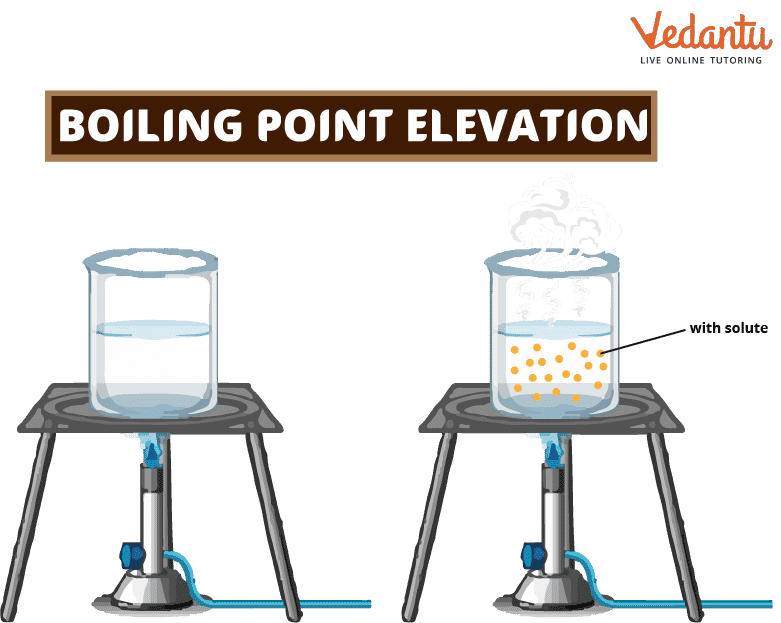




Boiling Point
The boiling point goes up when a substance is dissolved in a liquid. This is an example of a colligative property, which is a property that depends on the number of solute molecules and the number of solvent molecules but not on the type of solute.
What is the Elevation of Boiling Point?
When a solute is added to a solvent, the solvent's boiling point goes up. This is called "boiling point elevation." When a non-volatile solute is added to a solvent, the boiling point of the resulting solution is higher than that of the solvent by itself. For instance, a solution of sodium chloride (salt) and water has a higher boiling point than pure water.

Elevation of Boiling Point
The height of the boiling point is a colligative property of matter, which means that it depends on the ratio of solute to solvent but not on what the solute is. This means that the amount of solute added to a solution changes how high its boiling point goes. The boiling point rises the higher the concentration of solute in the solution.
Why does Boiling Point Elevation Occur?
A liquid's boiling point is the temperature at which the pressure of its steam is the same as the pressure of the air around it. Non-volatile things don't quickly evaporate, and their vapor pressures are shallow (assumed to be zero). When a non-volatile solute is added to a solvent, the solution has a lower vapor pressure than the solvent.
So, the solution needs more heat to boil. The rise in the solution's boiling point is called the boiling point elevation. When the added solute increases, the solution's boiling point goes up, and its vapor pressure goes down.
Uses of Boiling Point Elevation
As we know that it doesn't have many applications of elevation in boiling point, but it does have a few uses in everyday life that you may have seen. Let's discuss the uses of boiling point elevation:
Antifreeze - Ethylene Glycol or Antifreeze helps prevent radiator water from freezing. You may not have noticed it also raises the fluid's boiling point. Raising the boiling point prevents boil-overs. Many antifreeze manufacturers list boil-over and freeze-up prevention.
Cooking - Adding salt to water increases its boiling point, making it hotter when it boils. Adding a few grams of salt to 10 cups of water raises the boiling point by 0.015 degrees Celsius, which won't affect your cooking. Cooking uses boiling point elevation. Contrary to misconception, salting water won't help it boil quicker. Since its boiling point has risen, it will take longer to boil.
Molar Mass - Boiling point relies on the solvent and solute concentration, not the solute. Like freezing point depression, boiling point elevation may determine a solute's molar mass. The number of solute particles must also be considered if the solution contains an electrolyte, like sodium chloride, which splits when dissolved. Chemists employ mass spectrometry to estimate the molar mass of substances; however, boiling point elevation and freezing point depression are still options.
Refinery - Once sugarcane is harvested and the juice removed, it must be processed to make crystalline sugar. The temperature at which cane juice or syrup boils depends on its sugar content. The boiling point elevation helps monitor solution saturation, which is critical for crystallization.
Boiling Point Elevation Examples in Real Life
Pressure Cookers
Cooking with Salt
Sugar Refining
Antifreeze
Boiling Milk
Storage of Chemicals
Poor Cup of Tea at Mountains
High Altitude Cooking
Conclusion
The boiling point rises when a solute is added to a solvent. Adding a non-volatile solute to a solvent raises the boiling point of the solution. Sodium chloride solution and water boil higher than pure water. Boiling point elevation is a colligative feature of matter, meaning it relies on the solvent-to-solvent ratio but not the solute. Adding more solution raises a solution's boiling point. Higher solute concentration raises the boiling point.
FAQs on Boiling Point Elevation
1. How does the Boiling Point Elevation work?
In a nutshell, the boiling point goes up because most of the solutes stay in the liquid phase instead of going into the gas phase. For a liquid to boil, its vapor pressure must be higher than the pressure around it. This is harder to do when a non-volatile component is added.
2. What causes the boiling point to rising?
The vapor pressure at a liquid's boiling point equals the surrounding air pressure. Non-volatile chemicals don't evaporate and have low vapor pressures, usually 0. When a non-volatile solute is added to the solvent, the solution's vapor pressure is lower than the pure solvent. The solution needs more heat to boil. Boiling point elevation raises a solution's boiling point.
3. What is the relationship between Boiling Point and Vapor Pressure?
Elevating the boiling point clarifies vapor pressure. Vapor pressure is the force a vapor exerts on its condensed phases at a particular temperature. It measures the solvent's ability to escape into the gas phase. The liquid boils when vapor pressure equals air pressure. The pure liquid boiling point When the liquid's vapor pressure matches ambient pressure, it boils.









